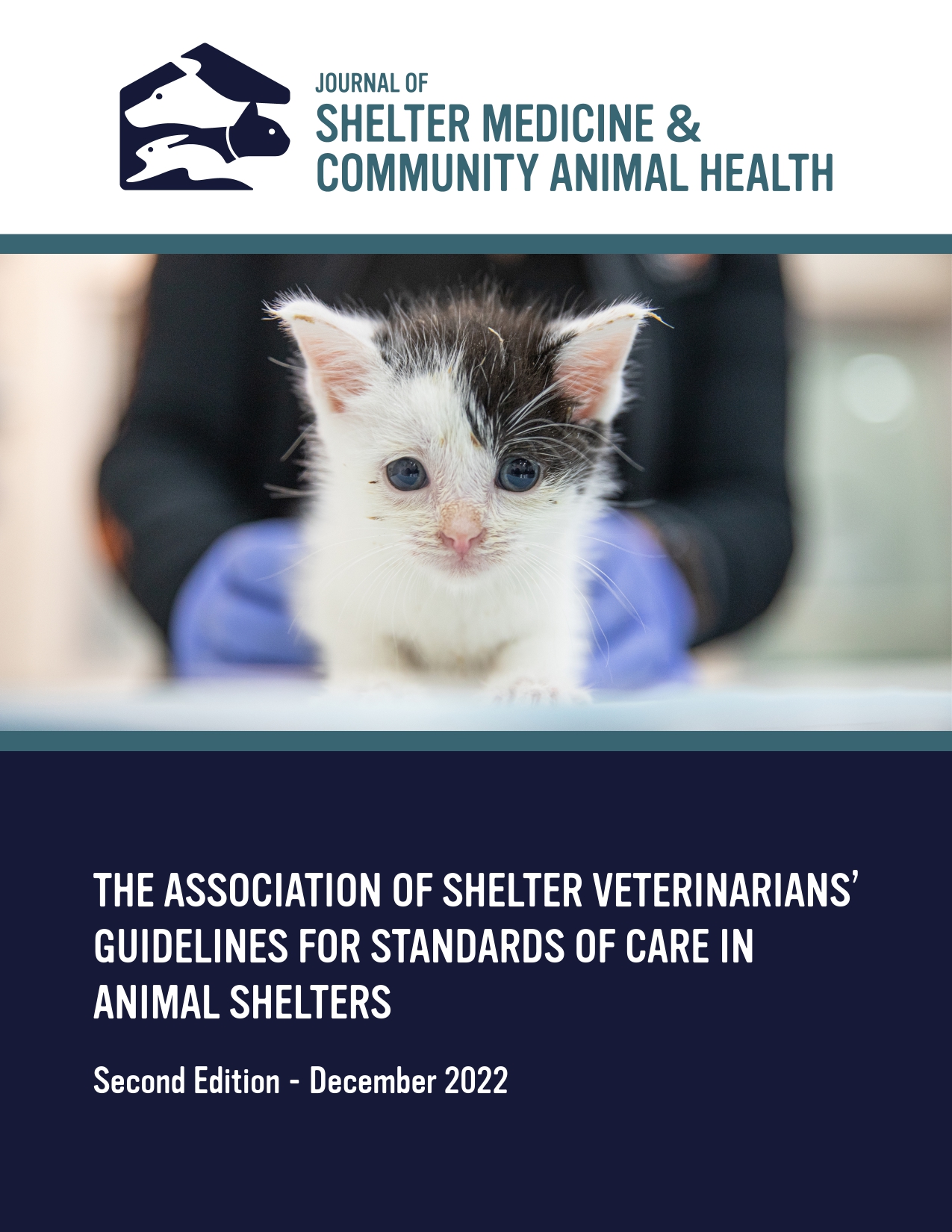Zoonotic and Non-Zoonotic Intestinal Parasites in Shelter Dogs at Admission and Before Discharge
DOI:
https://doi.org/10.56771/jsmcah.v2.9Keywords:
intestinal parasite, zoonotic parasite, dog, shelter, ToxocaraAbstract
Introduction: The prevalence of intestinal parasites, notably zoonotic ascarids and hookworms, is higher in shelter dogs, compared to dogs in homes, making parasite control within shelter facilities a public health priority.
Objective: The objective of the study reported here was to measure and compare the frequency of dogs infected with zoonotic or non-zoonotic intestinal parasites at admission and before discharge at a shelter facility.
Methods: Ninety-two dogs were tested for diagnosis of intestinal parasites at admission and before discharge.
Results: At admission, 50/92 (54%) dogs were diagnosed with intestinal parasites. Most dogs (43/50) were diagnosed with mono-infections with Ancylostoma spp., or co-infections with Ancylostoma spp. and Toxocara sp. or non-zoonotic parasites. Sixty-five dogs had a complete fecal study performed, which included an intake and exit sample analyzed for presence of parasite ova. Among the 65 study dogs, the frequency of dogs with intestinal parasites was lower before discharge (23 or 35%), compared to that at admission (33 or 50%) (P = 0.02). Fifty-one of 65 (78%) dogs were adopted, transferred to an outside rescue facility, or returned to their owners. Of these 51 dogs that left the shelter during the study period, 16/51 (31%) dogs were infected with intestinal parasites, and 8 of the 16 infected dogs were diagnosed with zoonotic parasites. Finally, among 37 dogs that tested negative and 28 that tested positive to zoonotic parasites at admission and re-tested later, four (11%) and six (21%) dogs, respectively, tested positive to zoonotic parasites when tested later.
Conclusion: The frequency of shelter dogs infected with intestinal parasites at admission and before discharge was high (≥35%), and most infections were caused by Ancylostoma spp., an intestinal parasite in dogs that can be transmitted to humans, particularly children. We offer health policy options that shelter veterinarians/managers and local policymakers can consider for possible implementation and evaluation.
Downloads
References
American Society for the Prevention of Cruelty to Animals (ASPCA). Pet statistics. https://www.aspca.org/animal-homelessness/shelter-intake-and-surrender/pet-statistics. Accessed March 9, 2020.
Little SE, Johnson EM, Lewis D, et al. Prevalence of intestinal parasites in pet dogs in the United States. Vet Parasitol. 2009;166:144–152. doi: 10.1016/j.vetpar.2009.07.044
Tupler T, Levy JK, Sabshin SJ, Tucker SJ, Greiner EC, Leutenegger CM. Enteropathogens identified in dogs entering a Florida animal shelter with normal feces or diarrhea. J Am Vet Med Assoc. 2012;241:338–343. doi: 10.2460/javma.241.3.338
Deplazes P, van Knapen F, Schweiger A, Overgaauw PAM. Role of pet dogs and cats in the transmission of helminthic zoonoses in Europe, with a focus on echinococcis and toxocariasis. Vet Parasitol. 2008;182:41–53. doi: 10.1016/j.vetpar.2011.07.014
Baneth G, Thamsborg SM, Otranto D, et al. Major parasitic zoonoses associated with dogs and cats in Europe. J Comp Pathol. 2016;155:S54–S74. doi: 10.1016/j.jcpa.2015.10.179
Esch KJ, Petersen CE. Transmission and epidemiology of zoonotic protozoal diseases of companion animals. Clin Microbiol Rev. 2013;26:58–85. doi: 10.1128/CMR.00067-12
Association for Shelter Veterinarians. Guidelines for standards of care in animal shelters. www.sheltervet.org/guidelines-for-standards-of-care-in-animal-shelters. Accessed June 23, 2022.
Katagiri S, Oliviera-Sequeira TG. Prevalence of dog intestinal parasites and risk perception of zoonotic infection by dog owners in Sao Paulo State, Brazil. Zoonoses Public Health. 2008;55:406–413. doi: 10.1111/j.1863-2378.2008.01163.x
Robertson ID, Irwin PJ, Lymbery AJ, Thompson RCA. The role of companion animals in the emergence of parasitic zoonoses. Int J Parasitol. 2000;30:1369–1377. doi: 10.1016/S0020-7519(00)00134-X
Torgerson PR, Macpherson C. The socioeconomic burden of parasitic zoonoses: a global trend. Vet Parasitol. 2011;182:79–95. doi: 10.1016/j.vetpar.2011.07.017
Macpherson CN. The epidemiology and public health importance of toxicariasis: a zoonosis of global importance. Int J Parasitol. 2013;43:999–1008. doi: 10.1016/j.ijpara.2013.07.004
Otranto D, Dantas-Torres F, Mihalca AD, Traub RJ, Lappin M, Baneth G. Zoonotic parasites of sheltered and stray dogs in the era of the global economic and political crisis. Trends Parasitol. 2017;33:813–826. doi: 10.1016/j.pt.2017.05.013
Companion Animal Parasite Council (CAPC). CAPC guidelines: hookworms. https://capcvet.org/guidelines/hookworms/. Accessed March 9, 2020.
Zajac AM, Conboy GA. Fecal examination for the diagnosis of parasitism in veterinary clinical parasitology. 8th ed. Ames, IA: Wiley-Blackwell Publishing; 2012.
Mohamed AS, Moore GE, Glickman LT. Prevalence of intestinal nematode parasitsm among pet dogs in the United States (2003–2006). J Am Vet Med Assoc. 2009;234:631–637. doi: 10.2460/javma.234.5.631
Raza A, Rand J, Qamar AG, Jabbar A, Kopp S. Gastrointestinal parasites in shelter dogs: occurrence, pathology, treatment and risk to shelter workers. Animals. 2018;8:108. doi: 10.3390/ani8070108
Magnaval JF, Glickman LT, Dorchies P. La toxocarose, une zoonose helminthique majeure. Rev Vet Med. 1994;145:611–627.
Overgaauw PM. Aspects of Toxocara epidemiology-toxocariasis in dogs and cats. Crit Rev Microbiol. 1997;23:233–251. doi: 10.3109/10408419709115138
Glickman LT, Schantz PM. Epidemiology and pathogenesis of zoonotic toxocariasis. Epidemiol Rev. 1981;3:230–250. doi: 10.1093/oxfordjournals.epirev.a036235
Bowman DD. Helminths in Georgis’ Parasitology for Veterinarians. 11th ed. St. Louis: Elsevier Saunders; 2021.
Jimenez Castro PD, Howell SB, Schaefer JJ, Avramenko RW, Gilleard JS, Kaplan RM. Multiple drug resistance in the canine hookworm Ancylostoma caninum: an emerging threat? Parasit Vectors. 2019;12:576. doi: 10.1186/s13071-019-3828-6
Published
Issue
Section
License
Copyright (c) 2023 Denaé N. Campanale, Heather D. S. Walden, Lawrence N. Garcia, P. Cynda Crawford, Jorge A. Hernandez

This work is licensed under a Creative Commons Attribution 4.0 International License.










